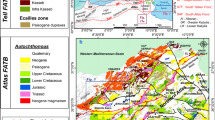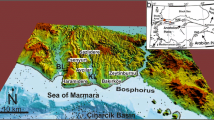Abstract
3-D seismic data obtained from Joint Development Zone (JDZ) Licensing Round, 2004, was used to investigate the structural and stratigraphic characteristics on distal parts of the outer fold and thrust belt of southern Niger Delta, Nigeria. Five main seismic reflectivity units (I, II, III, IV and V) were identified and interpreted based on seismic reflection patterns to represent the prograding cyclic sequence of sedimentation in the study area. These units record the episodic gravity spreading that is responsible for thrusting in the toe of the delta. Faults in the central parts of the study area exhibit hard linkage by the gradational propagation of segments into an overlap that developed into soft-linked relay structures. Thrust faults in the study area can be classified into two groups based on the width of the individual thrust faults and their extension and the geometry of the hanging wall folds. These are E–W south-verging thrusts and NE–SW SE-verging thrusts. In the proximal parts of the JDZ, thrust faults are widely spaced with a large structural closure of the hanging wall folds. Faults in the eastern part are complex and typically verge in the opposite direction. In the distal parts of the study area, thrust faults are regularly spaced with hanging wall folds that occasionally created bathymetric expressions on the seabed. The high concentration of pockmarks in the proximal JDZ and the large structural closure of the hanging wall folds characterized by stacked amplitude anomalies and discernable flat spots imply the possible existence of an active hydrocarbon system in the proximal JDZ. Several lenses of sills observed in unit III may impact on hydrocarbon generation and expulsion in the study area. If hydrocarbon migration into traps is occurring after the intrusion of magma, then the sills could act as a barrier to fluid flow, depending on post-emplacement tectonics. Seismic cross sections show that faults in the study area have variable cross-sectional geometries but possess scaling properties typical of thrust faults.

































Similar content being viewed by others
References
Ajakaiye DE, Bally AW (2002a) Course manual and atlas of structural styles of reflection profiles from Niger Delta. AAPG Contin Educ Course Note Ser 41:1–107
Ajakaiye DE, Bally AW (2002b) Some structural styles on reflection profiles from offshore Niger Delta. Search Discov 10031:1–6
Avbovbo AA (1978) Tertiary lithostratigraphy of the Niger Delta. AAPG Bull 62:295–300
Billotti F, Shaw JH (2005) Deepwater Niger Delta fold and thrust belt modelled as a critical-taper wedge: the influence of elevated basal fluid pressure on structural styles. AAPG Bull 89(11):1475–1491
Briggs SE, Davies RJ, Cartwright JA, Morgan R (2006) Multiple detachment levels and their control on fold styles in the compressional domain of the deepwater west Niger Delta. Basin Res 18:435–450
Briggs SE, Davies RJ, Cartwright JA (2009) Crustal structure of the deepwater west Niger Delta passive margin from the interpretation of seismic reflection data. Mar Pet Geol 26(6):936–950
Brown AR (2004) Interpretation of three-dimensional seismic data. AAPG Memoir/ SEG Investigations in Geophysics, no. 9
Burke KCB (1972) Longshore drift, submarine canyons, and submarine fans. AAPG Bull 56:1975–1983
Childs C, Manzocchi T, Walsh JJ, Bonson CG, Nicol A, Schopfer MPJ (2009) A geometric model of fault zone and fault rock thickness variations. J Struct Geol 31:117–127
Cobbold PR, Clark BJ, Loseth H (2009) Structural consequences of fluid overpressures and seepage forces in the outer thrust belt of the Niger Delta. Pet Geosci 15(1):p3–p15
Connors CD, Denson DB, Kristiansen G, Angstadt DM (1998) Compressive anticlines of the mid-outer slope, central Niger Delta. AAPG Bull 82:p1903
Corredor F, Shaw JH, Bilotti F (2005) Structural styles in the deep-water fold and thrust belts of the Niger Delta. AAPG Bull 89:753–780
Damuth JE (1994) Neogene gravity tectonics and depositional processes on the deep Niger delta continental margin. Mar Pet Geol 11(3):320–346
Doust, H., & Omatsola, E., (1990) Niger Delta divergent/passive margin basins. In J.D. Edwards and P.A. Santogrossi eds., AAPG memoir vol. 48, p201–238.
Ekweozor CM, Doukoru EM (1994) Northern delta depobelt portion of the Akata-Agbada petroleum system-from source to trap. AAPG Mem 45:599–613
Emery KO, Uchupi E, Phillips J, Brown C, Mascle J (1975) Continental margins off western Africa: Angola to Sierra Leone. AAPG Bull 59:2209–2265
Evamy BD, Haronboure J, Kamerling P, Knaap WA, Mollay FA, ROWLANDS PH (1979) Hydrocarbon habitat of Tertiary Niger Delta. AAPG Bull 62:p277–p298
Gay A, Lopez M, Cochonat P, Sultan N, Cauquil E, Brigaud F (2003) Sinuous pockmark belt as an indicator of a shallow buried turbiditic channel on the lower slope of the Congo basin. West Afr Margin Geol Soc Lond Spec Publ 216:173–189
Hovland M, Clenell B, Gallager JW, Lekvam K (1997) Gas hydrate and free gas volumes in marine sediments: example from the Niger Delta front. Mar Pet Geol 14(3):245–255
Knox GJ, Omatsola EM (1989) Development of the Cenozoic Niger Delta in terms of the “Escalator Regression” model and impact on hydrocarbon distribution. In: van der Linden WJM, Cloetingh SAPL, Kaasschieter JPK, van der Gun JAM (eds) Proceedings KNGMG symposiums coastal lowlands, geology and geotechnology. Kluwer Academic Publishers, Amsterdam, pp 181–202
Krueger SW, Grant NT (2006) Evolution of fault-related folds in the contractional toe of the deepwater Niger Delta. Paper presented at the AAPG Annual Convention Houston, Texas, 2006
Kulke H (1995) Regional petroleum geology of the world, part II, Africa, America, Australia, and Antarctica. Gebruder Borntraeger, Berlin, pp 143–172
Lehner P, De Ruiter PAC (1977) Structural history of the Atlantic margin of Africa. AAPG Bull 61:961–981
Maloney D, Davies R, Imber J, Higgins S, King S (2010) New insights into deformation mechanisms in the gravitationally driven Niger Delta deep-water fold and thrust belt. AAPG Bull 94(9):1401–1424
Mascle J (1976) Submarine Niger Delta structural framework. J Niger Min Geol Metal Soc 13:12–28
McClay KR, Dooley T, Lewis G (1998) Analog modeling of progradational delta systems. Geology 26:771–774
Morgan R (2003) Prospectivity in ultra-deep water: the case for petroleum generation and migration within the outer parts of the Niger Delta apron. In: Arthur TJ, McGregor DS, Cameron NR (eds) Petroleum geology of Africa: new themes and developing technologies. Geological Society, London, Special Publications, vol. 207, p151-164
Morley CK, Guerin G (1996) Comparison of gravity-driven deformation styles and behaviour associated with mobile shales and salt. Tectonics 15:1154–1170
Nwachukwu SO (1972) The tectonic evolution of the southern portion of the Benue Trough, Nigeria. Geol Mag 109:411–419
Osborne MJ, Swarbrick RE (1998) Mechanism for generating overpressure in sedimentary basins: a re-evaluation. AAPG Bull 81:1023–1041
Peacock DCP, Knipe RJ, Sanderson DJ (2000) Glossary of normal faults. J Struct Geol 22:291–305
Reijers TJA, Peters SW, Nwajide CS (1997) The Niger Delta basin. In: Selley RC (ed). African basins. Sedimentary basins of the world 3. Elsevier, p151-172
Rowan MG, Peel FJ, Vendiville BC (2004) Gravity-driven fold belts on passive margins. In: McClay KR (ed) Thrust tectonics and hydrocarbon systems. AAPG Memoir, vol. 82, p157-182
Short KC, Staeuble AJ (1967) Outline of geology of Niger Delta. AAPG Bull 51:p761–p779
Sultan N, Marsset B, Ker S, Marsset T, Voisset M, Vermant AM, Bayon G, Cauquil E, Adamy J, Colliat L, Drapeau D (2010) Hydrate dissolution as a potential mechanism for pockmarks formation in the Niger Delta. J Geophys Res 115(B08108):P1–P33
Suppe J (1984) Seismic interpretation of compressively reactivated normal fault near Hsinchu, western Taiwan. Pet Geol Taiwan 20:85–96
Suppe J, Medwedeff DA (1990) Geometry and kinematics of fault-propagation folding. Eclogae Geol Helv 83:409–454, Laubscher vol
Suppe J, Connors CD, Zhang, Y (2004) Shear fault-bend folding. In: McClay KR (ed) Thrust tectonics and hydrocarbon systems. AAPG Memoir, vol. 82, p303-323
Walsh JJ, Watterson J (1991) Geometric and kinematic coherence and scale effects on normal fault systems. In: Yielding G, Freeman B (eds). The geoemtry of Normal faults. The geological Society, London Special Publications, vol. 56, p193–203
Weber KJ, Daukoru EM (1975) Petroleum geology of the Niger Delta. 9th World Pet Congr Proc 2:p209–p221
Whiteman A (1982) Nigeria: its petroleum geology, resources and potential. Graham and Trotman, London
Wu S, Bally AW (2000) Slope tectonics—comparison and contrasts of structural styles of salt and shale tectonics of the northern Gulf of Mexico with shale tectonics of offshore Nigeria in Gulf of Guinea. In: Mohriak W, Talwani, M (eds) Atlantic rifts and continental margins. American Geophysical Union, p151 – 172
Acknowledgments
The authors would like to acknowledge the management of Kumasi Polytechnic, Kumasi, headed by the Rector Prof. N.N.N. Nsowah-Nuamah, for providing financial assistance. Special thanks go to Oil and Gas Resource and Digital Geo-Processes, Yangtze University and Research Institute of China National Offshore Oil Corporation for providing 3-D seismic data.
Author information
Authors and Affiliations
Corresponding author
Rights and permissions
About this article
Cite this article
Nyantakyi, E.K., Li, T., Hu, W. et al. Structural and stratigraphic characteristics on distal parts of the outer fold and thrust belt of southern Niger Delta, Nigeria. Arab J Geosci 8, 6677–6695 (2015). https://doi.org/10.1007/s12517-014-1727-x
Received:
Accepted:
Published:
Issue Date:
DOI: https://doi.org/10.1007/s12517-014-1727-x




